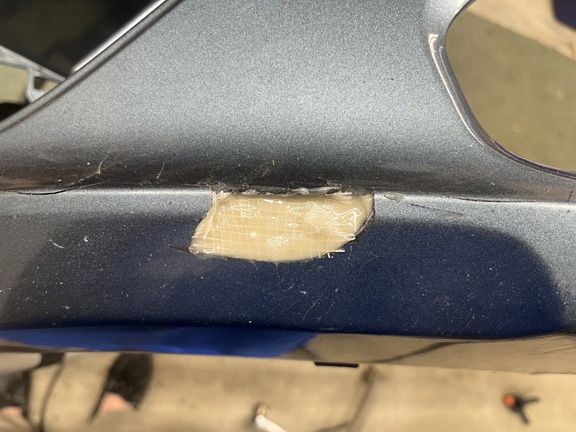JB Weld is an epoxy putty that can be used to repair many materials, including plastic bumpers. With proper preparation and application, JB Weld can form a strong, long-lasting bond on plastic bumpers. However, there are some important factors to consider before using JB Weld on a bumper.
Page Contents
Quick Answers
– Yes, JB Weld can be used to repair cracks, holes, and damage on plastic bumpers. It bonds strongly to many plastics.
– The bumper area must be cleaned, dried, and sanded for the best bond. Proper preparation is key.
– Only small cracks, holes, and damage should be repaired with JB Weld. It is not suitable for large repairs or severely damaged bumpers.
– JB Weld forms a rigid bond. It is not flexible like automotive plastic epoxies. The repair area should not flex or be exposed to impacts.
– For the best results, use JB Weld plastic bonder instead of original JB Weld. It is formulated for better adhesion to plastics.
Suitability of JB Weld for Bumper Repairs
JB Weld is an epoxy putty consisting of two parts which must be kneaded together to activate the epoxy. It is commonly used for minor repairs on materials like metal, wood, and certain plastics. When cured, it forms a rigid, permanent bond. While not specifically designed for automotive use, it can work well for minor plastic bumper repairs if used properly.
The suitability of JB Weld depends on the type and extent of damage. Small holes, cracks, and punctures in the bumper can often be effectively repaired with JB Weld. However, it is not recommended for large holes, deep gashes, or severely damaged areas. JB Weld forms a hard epoxy bond that does not flex. Any areas that require flexibility or impact resistance may eventually fail with JB Weld.
For best results, the JB Weld plastic bonder product should be used instead of original JB Weld. It contains additives and compounds that increase adhesion to many plastics. Make sure to follow preparation and application instructions carefully.
Ideal Repair Conditions for JB Weld on Bumpers
There are certain conditions and damage types where JB Weld can work well to repair bumpers:
- Small holes and punctures from impact damage, up to about 1 inch wide.
- Hairline cracks or fractures, especially on bumper corners and edges.
- Split seams or small gaps where the bumper material has separated.
- Areas that do not regularly flex or require flexibility.
- Low impact zones away from vehicle corners.
JB Weld bonds best when the repair area does not require heavy impact resistance or flexibility. It should be used only on suitable bumper damage based on the location and expected movement.
Preparation Steps for JB Weld Bumper Repair
Proper preparation is extremely important for the best bond when using JB Weld on plastics. Here are the key steps:
- Thoroughly clean the area with isopropyl alcohol or another non-oil based cleaner/degreaser. Remove any dirt, oil, and debris.
- Lightly sand the area to roughen and score the surface. This allows the epoxy to mechanically bond.
- Make sure the area is completely dry before applying JB Weld.
- Use the JB Weld plastic bonder product for better adhesion.
- Knead the putty thoroughly until uniform color to properly mix the epoxy.
Taking the time to correctly prepare the bumper area will help the JB Weld maintain a long lasting bond. Rushing this process can cause the repair to eventually fail.
Step-by-Step JB Weld Bumper Repair Instructions
Once the area is prepped, follow these steps for the JB Weld application:
- Mix the epoxy putty thoroughly until it achieves an even color with no streaks.
- Force the putty into any cracks or holes. Apply slightly more than needed.
- Firmly press it into the repair area to displace any air pockets.
- Let the epoxy cure fully without disturbing it, at least 24 hours.
- Once cured, sand and smooth the repair area if needed.
- Paint or coat the repair if desired to match the bumper.
Applying the JB Weld correctly is vital for proper adhesion and curing. Follow the product instructions closely. The repaired area can be lightly sanded, smoothed, and painted once fully cured.
JB Weld Bumper Repair Effectiveness & Durability
When used properly under the right conditions, JB Weld can be a simple, economical solution for minor bumper repairs. However, it does have some limitations:
- Repairs may not withstand significant impacts or flexing.
- It cannot match specialized flexible auto repair epoxies.
- For best results, only small repairs in low impact areas.
- Not recommended for structural bumper repairs.
Expect JB Weld bumper repairs to last 1-3 years with proper preparation and application. Larger repairs or high impact areas may fail sooner. JB Weld works best as a temporary fix on small, localized damage away from bumper corners.
Conclusion
JB Weld can form an effective, long-lasting bond on plastic bumpers when used to repair small holes, cracks, or damage in low impact areas. While not as flexible as some automotive epoxies, it can be a quick, inexpensive solution for minor repairs if properly prepped and applied. The JB Weld plastic bonder has enhanced adhesion to plastics. It is best suited for repairs up to about 1 inch in size where the area does not regularly flex. While not a permanent fix for all bumper damage, JB Weld can be a handy temporary repair when used selectively under the right conditions.

